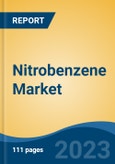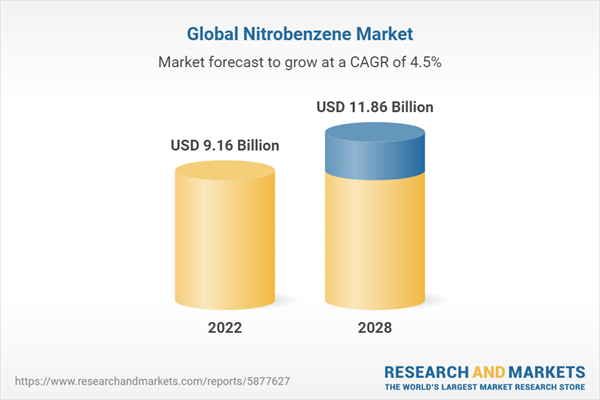Speak directly to the analyst to clarify any post sales queries you may have.
10% Free customizationThis report comes with 10% free customization, enabling you to add data that meets your specific business needs.
Nitrobenzene, with a chemical formula of C6H5NO2, is an organic molecule known for its solubility in water, pale yellow oil-like appearance, and almond-like scent. It forms greenish-yellow crystals when frozen and is primarily produced from benzene, which serves as a precursor for aniline. Nitrobenzene also finds occasional use as a solvent, particularly for electrophilic reagents. Its production involves the nitration of benzene using a solution of strong nitric acid, water, and sulfuric acid.
Due to the exothermic nature of the reaction, the production of nitrobenzene is considered one of the most hazardous processes in the chemical industry. The nitration process leads to the formation of the nitronium ion (NO2+) through the reaction of an acidic dehydrating agent, often sulfuric acid, and nitric acid. Aniline, a key compound derived from nitrobenzene, finds applications in the production of rubber compounds, azo colors, urethane polymers, insecticides, drugs, and explosives. The extensive range of applications of these organic compound derivatives contributes significantly to the sector's growth.
Nitrobenzene plays a vital role in the production of agrochemicals like herbicides and fungicides, which safeguard crops from pests and diseases in the agriculture sector. The increasing global demand for food, driven by population growth, is anticipated to boost the demand for agrochemicals and subsequently drive the demand for nitrobenzene. Additionally, nitrobenzene finds application in the production of rubber products such as tires, belts, and hoses, which are in high demand in the automotive industry. The growth of the automotive sector is expected to fuel the demand for these products and, consequently, for nitrobenzene.
With the Construction Market estimated at around USD 12 trillion in 2019, witnessing a 4% growth compared to the previous year, there is a rising demand for rigid polyurethanes, adhesives, sealants, binders, coatings, and other MDI products. This surge in demand subsequently boosts the market for aniline, thereby supporting the growth of the studied market.
The increasing demand from the automotive industry serves as a significant driver for market growth.
Anticipated future market growth for nitrobenzene is expected to be driven by increasing demand from the automotive sector. The automotive sector encompasses the manufacturing, distribution, retail, and maintenance of automobiles. A significant portion of the nitrobenzene is utilized in the production of aniline, a precursor of methylene diphenyl diisocyanate (MDI). MDI is used in the production of high-performance plastics, urethane polymers such as polyurethane foams and elastomers, rubber compounds, and other automotive-related goods.
For example, according to a report from the International Energy Agency, an intergovernmental organization based in France that provides recommendations to the global energy sector, the number of electric cars on the road has nearly doubled from the previous year, reaching 16.5 million (with a sales share of about 9% of total car sales). This growth in electric cars contributes to the expanding nitrobenzene market due to the rising demand from the automobile industry.
In addition to the automotive sector, the chemicals and solutions industry also plays a vital role in the growth of the nitrobenzene market. The increasing demand for aniline across various business verticals is one of the significant driving forces behind the global nitrobenzene market. Manufacturers offer both powder and liquid forms of these products and services to end consumers. The producers and market participants in the global nitrobenzene market provide distinct product types categorized according to their intended end use, such as industrial, pharmaceutical, and agricultural-grade items.
The application segment dominated by aniline manufacturing is expected to drive the nitrobenzene market. Aniline is primarily produced through the catalytic hydrogenation of nitrobenzene. The method involving phenyl amination to produce nitrobenzene is no longer in use. An estimated 87% of the aniline produced is used to manufacture MDI, while the remaining nitrobenzene is utilized in other processes such as the production of p-aminophenol, insecticides, dyes, pigments, and chemical intermediaries or solvents.
Methylene diphenyl diisocyanate (MDI) derived from aniline serves as a key precursor for polymers used in various end-use industries, including the construction and automotive sectors. MDI-based polyurethane foams, widely employed in building insulation applications, are fundamental building blocks in both flexible and rigid forms.
The demand for aniline from the pharmaceutical industry, particularly for the production of paracetamol, has increased, leading to a corresponding increase in the demand for the nitrobenzene market, as reported by the India Brand Equity Foundation (IBEF). In 2019, the Indian pharmaceutical market size was valued at USD 20.03 billion, with a year-over-year growth rate of 9.8%.
The rising demand for agrochemicals is anticipated to drive future market expansion for nitrobenzene. Agrochemicals refer to agents used to eliminate, deter, or control plant or animal pests. Nitrobenzene is used in agriculture as a supplement for plant growth, promoting flowering and reducing flower loss. It acts as a combination of nitrogen and a plant growth regulator, stimulating plant growth and increasing yield.
According to the Food and Agriculture Organization, the average annual consumption of pesticides was 1.58 kg per hectare, 0.37 kg per person, and 0.79 kg for every USD 1,000 of agricultural production. In 2020, the total volume of pesticide trade increased by 30%. This rising need for agrochemicals contributes to the expanding market for nitrobenzene.
The nitrobenzene market faces a major challenge from the increasing demand for bio-based fertilizers. Regulatory guidelines adopted by the European Union Commission and the US Environmental Protection Agency to limit volatile organic compound (VOC) emissions are projected to raise demand for bio-based chemicals and hinder the growth of the nitrobenzene market. Furthermore, nitrobenzene has been designated as a potential occupational carcinogen by the US Environmental Protection Agency, which may present significant obstacles for the industry in the near future. The growing environmental concerns regarding organic fertilizers are also expected to constrain the expansion of the nitrobenzene industry.
Recent Developments
- To enhance the organization's business and provide equipment, engineering design, and advisory services for a new nitrobenzene project, Kutch Specialties Pvt Ltd, an Indian company, was awarded a contract by KBR Inc. in 2020. The contract was for their exclusive Plinke Adiabatic Nitrobenzene solutions, known for their ability to produce high purity nitrobenzene.
- TIn 2020, The Chemours Company announced its decision to discontinue the production of aniline, nitrobenzene, and other chemicals at its Pascagoula, Mississippi facility in the United States. This plant was acquired by DuPont as part of their 2002 acquisition of ChemFirst and later integrated into The Chemours Company's operations. Additionally, in 2016, the company sold an aniline factory in Beaumont, Texas to Dow.
- In April 2022, Synthomer PLC, a UK-based chemicals company, completed the acquisition of Eastman Chemical Company's adhesive resins business for a total of USD 1 billion. This strategic move aimed to strengthen its presence in key markets such as building and construction, transportation, and consumables. Eastman Chemical Company, based in the US, is a prominent player in the chemicals industry.
Market Segmentation
Global Nitrobenzene Market is segmented based on form, application, region and competitive landscape. Based on the form, the market is categorized into Liquid and Powder. Based on the application, the market is segmented into Aniline Production, Lubricating Oils, Dyes & Paints, Synthetic Rubber, Pesticides, and Others. Based on region, the market is divided into North America, Europe, Asia Pacific, South America, Middle East & Africa.Market Players
Total S.A., Covestro AG, BASF SE, Huntsman Corporation, The Dow Chemical Company, The Chemours Company, Aarti Industries Ltd., Wanhua Industrial Group, Aromsyn Co Ltd, Bann Quimica Ltda, are some of the key players of the Global Nitrobenzene Market.Report Scope
In this report, Global Nitrobenzene Market has been segmented into the following categories, in addition to the industry trends, which have also been detailed below:Nitrobenzene Market, by Form:
- Liquid
- Powder
Nitrobenzene Market, by Application:
- Aniline Production
- Lubricating Oils
- Dyes & Paints
- Synthetic Rubber
- Pesticides
- Others
Nitrobenzene Market, by Region:
- North America
- Europe
- Asia-Pacific
- South America
- Middle East & Africa
Competitive landscape
Company Profiles: Detailed analysis of the major companies present in Global Nitrobenzene market.Available Customizations
The following customization options are available for the report:- Detailed analysis and profiling of additional market players (up to five).
This product will be delivered within 1-3 business days.
Table of Contents
Companies Mentioned
- Total SA
- Covestro AG
- BASF SE
- Huntsman Corporation
- The Dow Chemical Company
- The Chemours Company
- Aarti Industries Ltd.
- Wanhua Industrial Group
- Aromsyn Co Ltd.
- Bann Quimica Ltda
Table Information
| Report Attribute | Details |
|---|---|
| No. of Pages | 111 |
| Published | August 2023 |
| Forecast Period | 2022 - 2028 |
| Estimated Market Value ( USD | $ 9.16 Billion |
| Forecasted Market Value ( USD | $ 11.86 Billion |
| Compound Annual Growth Rate | 4.4% |
| Regions Covered | Global |
| No. of Companies Mentioned | 10 |









